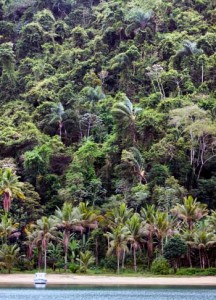By Marcelene Sutter

Who could say no to a face like that? Meet the golden lion tamarin, native to Brazil and so beloved by citizens there that it appears on the country’s currency. Brazil’s Atlantic Forest, or Mata Atlantica to locals, is the only place where these tiny primates can be found in the wild. Unfortunately, the rise of deforestation in the region poses a serious threat to the safety of this species. What was once an expansive ecosystem has shrunk from 500,000 square miles to less than 10,000 — and with it shrunk the tamarin population.
A concentrated effort to preserve this lion-maned tamarin began in the 1970s and focused mainly on breeding in captivity. By that point, there were fewer than 200 golden lion tamarins living in the wild. Through zoo breeding programs and other conservation programs, today, more than 1,700 golden lion tamarins live in patches of remaining forest, an improvement, but the problem is, if something doesn’t change in regard to habitat for these beloved monkeys, the entire conservation effort may still be for naught. There is no way to sustain this comeback without more available forests to facilitate population growth.

As it stands, deforestation in the region is not slowing, especially with the recent discovery of oil reserves north of the Atlantic Forest and the addition of two more lanes to the highway that cuts through the area. This has created another problem: On top of shrinking forest areas, what is left for the monkeys has become extremely fragmented. The still-recovering tamarin population is now separated into isolated remaining forest areas, a detriment to their genetic diversity.
One conservationist’s proposed solution to this problem of fragmentation is a bit unorthodox: Luis Paulo Ferraz, leader of the Golden Lion Tamarin Association, aims to construct a bridge over the highway for the tamarins. This bridge would need to be structurally sound enough not to be disrupted by the trucks below and would also need to be covered to provide the crossing tamarin with protection from predatory birds. Ferraz’s group, along with its American partner, Save the Golden Lion Tamarin, have been working together on ground-level models of this project within a golden lion tamarin reserve for years. In fact, as of December 2012, more than 68,000 acres of forest are connected by these planted corridors.
American Forests recognizes the importance of protecting endangered species in Brazil, which is why we’ve participated in tree plantings at three separate sites in the Atlantic Forest, for a total of 24,860 trees. This and a multitude of other projects for endangered species have been accomplished over the years through our Global ReLeaf program. For instance, currently, the orangutan population in the Dolok Sibual Buali Nature Reserve in Indonesia faces challenges similar to those of the golden lion tamarin, which is why American Forests and the Sumatra Rainforest Institute (SRI) are reforesting 140 acres of degraded Sumatran orangutan habitat in the Batang Toru forest. To learn more about orangutan habitat resoration or any of our 2013 Global ReLeaf projects, visit the Global ReLeaf area of our website.